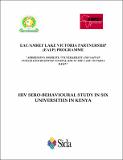| dc.description.abstract | Universities and institutions of higher learning in general consist mainly of
young people in the 17-24 year old category, most of whom are sexually active,
and therefore most vulnerable to HIV infection. And though studies such as
KAIS (2007) and KDHS (2003, 2008) have been conducted on the general Kenyan
population, studies specific to institutions of higher learning are scanty, in
particular, sero-prevalence data on this target group is lacking. This prompted
the EALP/IUCEA to commission a study to understand the extent, nature and
impact as well as response to HIV and AIDS within universities. The purpose of
this assignment therefore was to generate an understanding of the way that
HIV/AIDS is affecting universities and host communities and to identity
responses and gaps in the management of the pandemic that could be used to
strengthen and expand interventions at national and regional levels. The study
had a total representative sample of 3942 students drawn from six universities in
Kenya, four of which were from the Lake Victoria Basin region. Thus, this study
is aimed at providing evidence to guide the responses and policy formulation to
the challenge of HIV in institutions of higher learning Findings of the EALP/IUCEA HIV and AIDS baseline study in institutions of
higher learning carried from 1st March to 12th March and from 25th May to 5th
June 2009, revealed that 20 (0.51%) of the 3942 respondents were diagnosed as
infected with HIV at the time of the survey. Significantly greater prevalence was
recorded among men (0.58%) than women (0.40%) Thus, HIV prevalence among
students at Kenyan universities is way below the national average of 3.8% for the
age group of 15-24 years (KAIS, 2007) where most belong. HIV prevalence
among male students was within the national range of 0.4% to 2.6% for that age
group. However, HIV prevalence among female students was well below the
national range of 3% to 12% for the age group. HIV prevalence among total
orphans was higher than other parenthood groups
Sexual debut was at 18 years and was earlier in males than females. For those
testing HIV positive, sexual debut was one year earlier at 17 years. Primary
abstinence was reported in a quarter of the respondents, was higher in females,
and decreased with increase in year of study. The main reasons given for
abstinence were religion (70%), followed by waiting for marriage (66.5%) and
fear of contracting HIV (62.3%). The prevalence of the high risk anal sex was
generally low at 2.5%. However, anal sex for HIV positives respondents was four
times higher than the overall prevalence rate in the study. | en_US |

